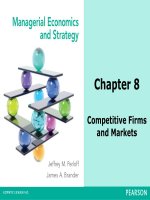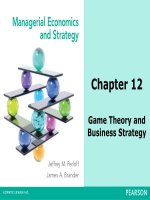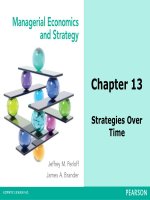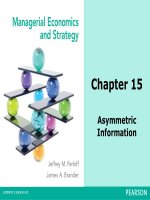Managerial economics strategy by m perloff and brander chapter 6 costs
Bạn đang xem bản rút gọn của tài liệu. Xem và tải ngay bản đầy đủ của tài liệu tại đây (736.92 KB, 39 trang )
Chapter 6
Costs
Table of Contents
•
6.1 The Nature of Costs
•
6.2 Short-Run Costs
•
6.3 Long-Run Costs
•
6.4 The Learning Curve
•
6.5 Costs of Producing Multiple Goods
6-2
© 2014 Pearson Education, Inc. All rights reserved.
Introduction
• Managerial Problem
– Technology choice at home versus abroad: In the United States, firms use relatively
capital-intensive technology
– Will that same technology be cost minimizing if they move their production abroad?
• Solution Approach
– First, a firm must determine which production processes are technically efficient so
that it can produce the desired level of output without waste. Second, a firm should
pick from these technically efficient processes the one that is also economically
efficient (minimum cost). By minimizing costs, a firm can increase its profit.
• Empirical Methods
– When considering costs, a good manager includes opportunity costs or foregone
alternatives.
– To minimize costs, a manager should distinguish short-run costs from long-run costs.
– Firms may reduce costs overtime based on experience or its learning curve.
– If a firm produces several goods, individual cost may depend on the cost of
producing multiple goods.
6-3
© 2014 Pearson Education, Inc. All rights reserved.
6.1 The Nature of Costs
• Explicit and Implicit Costs
– Explicit costs are direct, out-of-pocket payments for labor, capital, energy,
and materials.
– Implicit costs reflect only a foregone opportunity rather than explicit,
current expenditure.
• Opportunity Costs
– The opportunity cost of a resource is the value of the best alternative use of
that resource.
– Value of Manager’s Time example: Maoyong owns and manages a firm. He
pays himself only $1k per month but could work for another firm and make
$11k per month. Working for another firm is the best alternative use of his
time, so his opportunity cost of time is $11k.
• Relevance of Considering Opportunity Cost
– Maoyong example: Assume monthly revenue is $49k and explicit costs are
$40k, including Maoyong’s monthly wage. The accounting profit is $9k and
Maoyong collects $10k per month (profit + wage). However, his opportunity
cost is $11k. So, he incurs an economic loss of $1k.
6-4
© 2014 Pearson Education, Inc. All rights reserved.
6.1 The Nature of Costs
• Costs of Durable Inputs
– Durable inputs are usable for a long period, perhaps for many
years.
– Capital such as land, buildings, or equipment are durable inputs.
• Costs of Durable Inputs (truck example)
– There are two problems. First, how to allocate the initial purchase
cost over time. Second, what to do if the value of the capital
changes over time.
– Solution if there is a rental market: The accountant may expense
the truck’s purchase price or may amortize it over the life of the
truck, following IRS rules. The firm’s opportunity cost of using the
truck is the amount that the firm would earn if it rented the truck
to others.
– Solution if there is no rental market: The opportunity cost of capital
of using the truck a year would be the interest forgone in a year.
6-5
© 2014 Pearson Education, Inc. All rights reserved.
6.1 The Nature of Costs
• Sunk Costs
– Sunk cost is a past expenditure that cannot be recovered.
– If an expenditure is sunk, it is not an opportunity cost. So we should
not consider it for managerial decisions.
– However, sunk costs appear in financial accounts.
• Managers Should Ignore Sunk Costs
– A firm paid $300k for a parcel of land but the market value is now
$200k. If the firm builds a plant on this land, the value for the firm
becomes $240k.
– Is it worth carrying out production on this land or should the land be
sold for its market value of $200k?
– The land’s opportunity cost is $200k and the market value loss of
$100k is a sunk cost. The sunk cost cannot be recovered and should
not be considered in the decision. The values to compare are $240
versus $200. Certainly, the firm should carry out production on this
land.
6-6
© 2014 Pearson Education, Inc. All rights reserved.
6.2 Short-Run Costs
Common Measures of Cost
• Fixed Cost (F) does not vary with the level of output; includes
expenditures on land, office space, production facilities, and other
overhead expenses; are often sunk costs, but not always.
• Variable Cost(VC) changes as the quantity of output changes;
refers to the costs of variable inputs.
• Total Cost (C) is the sum of fixed and variable costs.
• F and VC should be based on inputs’ opportunity costs.
6-7
© 2014 Pearson Education, Inc. All rights reserved.
6.2 Short-Run Costs
• Average Fixed Cost (AFC) falls as output rises because the
fixed cost is spread over more units.
• Average Variable Cost (AVC) or variable cost per unit of
output may either increase or decrease as output rises.
• Average Cost (AC) or average total cost may either increase
or decrease as output rises.
6-8
© 2014 Pearson Education, Inc. All rights reserved.
6.2 Short-Run Costs
• Marginal Cost: MC = ΔC/Δq
– Marginal cost (MC) is the amount by which a firm’s cost
changes if the firm produces one more unit of output; ∆C is
the change in cost when the change in output, ∆q, is 1 unit.
• Marginal Cost: MC = ΔVC/Δq
– Marginal cost also equals the change in variable cost from
a one-unit increase in output.
• Marginal Cost using Calculus: MC = dC/dq = dVC/dq
– Marginal cost is the rate of change of cost as we make an
infinitesimally small change in output. MC=dVC/dq because
dF/q=0.
6-9
© 2014 Pearson Education, Inc. All rights reserved.
6.2 Short-Run Costs
• Cost Curves: Total Values
– Panel a of Figure 6.1 shows the variable cost (VC), fixed cost (F), and total
cost (C) curves that correspond to Table 6.1
• Graphs: Total, Variable and Fixed Costs
– The fixed cost curve, F, is a horizontal line at $48.
– The variable cost curve, VC, is zero at zero units of output and rises with
output.
– The total cost curve, C, is the vertical sum of the VC and F curves, so it is
$48 higher than the VC curve at every output level. VC and C curves are
parallel.
6-10
© 2014 Pearson Education, Inc. All rights reserved.
6.2 Short-Run Costs
Figure 6.1 Cost Curves
6-11
© 2014 Pearson Education, Inc. All rights reserved.
Table 6.1 How Cost Varies with
Output
6-12
© 2014 Pearson Education, Inc. All rights reserved.
6.2 Short-Run Costs
• Cost Curves: Average and Marginal Values
– Panel b of Figure 6.1 shows the average fixed cost, average
variable cost, average cost, and marginal cost curves.
• Graphs: Average Costs and Marginal Cost
– The marginal cost curve, MC, cuts the average variable
cost, AVC, and average cost, AC, curves at their minimums.
– The height of the AC curve at point a equals the slope of
the line from the origin to the cost curve at A.
– The height of the AVC at b equals the slope of the line from
the origin to the variable cost curve at B.
– The height of the marginal cost is the slope of either the C
or VC curve at that quantity.
6-13
© 2014 Pearson Education, Inc. All rights reserved.
6.2 Short-Run Costs
Production Functions and the Shapes of Short-Run Costs Curves
• In the short run, the firm increases output by using more
labor. However, each extra worker increases output by a
smaller amount. Diminishing marginal returns to labor
determine the shape of the production function.
• The production function determines the shape of the
variable cost curve. As output increases, variable cost
increases more than proportionally because of diminishing
marginal returns.
• The production function determines the shape of the
marginal cost, average variable cost, and average cost
curves.
6-14
© 2014 Pearson Education, Inc. All rights reserved.
6.2 Short-Run Costs
• Production Functions & Shapes of Cost Curves:
Graph Analysis
– If input prices are constant, the firm’s production function
determines the shape of the variable cost curve.
• The Variable Cost Curve
– The VC and the total product curve have the same shape, Figure
6.2.
– The total product curve uses the horizontal axis measuring hours
of work.
– The variable cost curve uses the horizontal axis measuring labor
cost: VC = wL.
– The VC of 6 units of output is $240 ($10*24).
6-15
© 2014 Pearson Education, Inc. All rights reserved.
6.2 Short-Run Costs
Figure 6.2 Variable Cost and Total
Product
6-16
© 2014 Pearson Education, Inc. All rights reserved.
6.2 Short-Run Costs
The Marginal Cost Curve
MC = ∆VC/∆q
• Marginal cost is the
change in variable
cost as output
increases by one
unit.
• Diminishing
marginal returns
determine the
shape of the
marginal cost curve.
• The marginal cost
curve is U-shaped.
6-17
∆VC/∆q = w(∆L/∆q)
• In the short run, capital
is fixed. So, the change
in variable cost as
output increases by
one unit, MC, is the
change in the cost of
labor.
• The marginal cost
equals the wage times
the extra labor
necessary to produce
one more unit of
output.
© 2014 Pearson Education, Inc. All rights reserved.
MC = w/MPL
• Remember MPL =
Δq/ΔL
• So, ΔL/Δq is just
the inverse of MPL.
• Marginal cost
equals wage
divided by
marginal product of
labor.
• Marginal product of
labor and marginal
cost move in
opposite directions
as output changes.
6.2 Short-Run Costs
The Average Cost Curve
AVC = VC/q
VC/q = wL/q
• Average variable cost
is the variable cost
divided by output.
• Diminishing marginal
returns to labor also
determine the shape
of the average
variable cost curve.
• The average variable
cost curve is Ushaped.
• The average cost
curve is also Ushaped.
• In the short run, capital
is fixed. So the variable
cost is wL.
6-18
• The average variable
cost is wL divided by
output.
© 2014 Pearson Education, Inc. All rights reserved.
AVC = w/APL
• Remember APL =
q/L
• So, L/q is just the
inverse of APL.
• Average variable
cost equals wage
divided by average
product of labor.
• Average product of
labor and average
variable cost move
in opposite
directions.
6.2 Short Run Costs
• Short-Run Cost Summary
– In the short run, the cost associated with fixed inputs is fixed,
while the cost from inputs that can be adjusted is variable.
– Given that input prices are constant, the shapes of the
variable cost and the cost-per-unit curves are determined by
the production function.
– Where there are diminishing marginal returns, the variable
cost and cost curves become relatively steep as output
increases, so the average cost, average variable cost, and
marginal cost curves rise with output.
– The average cost and average variable cost curves fall when
marginal cost is below them and rise when marginal cost is
above them, so the marginal cost cuts both these average
cost curves at their minimum points.
6-19
© 2014 Pearson Education, Inc. All rights reserved.
6.3 Long Run Costs
• Input Choice
– In the long run, the firm adjusts all its inputs so that its cost of
production is as low as possible.
– The firm can change its plant size, design, build new
machines, and otherwise adjust inputs that were fixed in the
short run.
• Technically and Economically Efficient
– From among the technically efficient combinations of inputs
that can be used to produce a given level of output, a firm
wants to choose that bundle of inputs with the lowest cost of
production, which is the economically efficient combination of
inputs.
– To do so, the firm combines information about technology from
the isoquant with information about the cost of production.
6-20
© 2014 Pearson Education, Inc. All rights reserved.
6.3 Long Run Costs
6-21
© 2014 Pearson Education, Inc. All rights reserved.
6.3 Long Run Costs
Figure 6.3 A Family of Isocost Lines
6-22
© 2014 Pearson Education, Inc. All rights reserved.
6.3 Long Run Costs
• Isocost and Isoquant Combined
– The firm minimizes its cost by using the combination of inputs on the
isoquant that is on the lowest isocost line that touches the isoquant.
• Isocost and Isoquant Combined: Graph Analysis
– In Figure 6.4, the lowest possible isoquant that will allow the beer
manufacturer to produce 100 units of output is tangent to the $2,000
isocost line.
– At x, the bundle of inputs are L = 50 workers and K = 100 units of capital.
– At x, the isocost is tangent to the isoquant, so the slope of the isocost, –
w/r = –3, equals the slope of the isoquant, which is the negative of the
marginal rate of technical substitution.
– Notice, y and z also produce 100 units of output but at a cost of $3,000.
The x input combination is economically efficient.
6-23
© 2014 Pearson Education, Inc. All rights reserved.
6.3 Long Run Costs
Figure 6.4 Cost Minimization
6-24
© 2014 Pearson Education, Inc. All rights reserved.
6.3 Long Run Costs
Three Equivalent Rules to Minimize Costs in the Long-Run
• The Lowest Isocost Rule
– The firm minimizes its cost by using the combination of
inputs on the isoquant that is on the lowest isocost line that
touches the isoquant.
• The Tangency Rule: MRTS = - w/r
– At the minimum-cost bundle, x, the isoquant is tangent to the
isocost line. The slope of the isoquant (MRTS) and the slope
of the isocost are equal.
• The Last-Dollar Rule: (MPL/w) = (MPK/r)
– Cost is minimized if inputs are chosen so that the last dollar
spent on labor adds as much extra output as the last dollar
spent on capital. Thus, spending one more dollar on labor at
x gets the firm as much extra output as spending the same
amount on capital.
6-25
© 2014 Pearson Education, Inc. All rights reserved.









